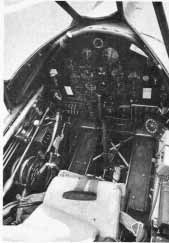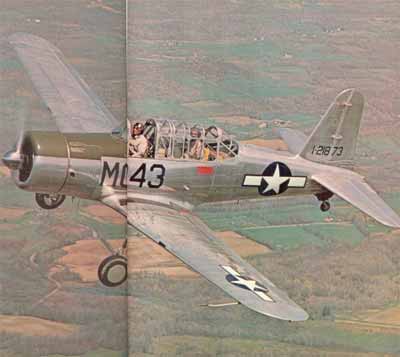PAGE TWO
M043 is really pretty, inside and out. The outside is smooth and shiny,
and the inside is covered with a completely intact coat of
zinc chromate. Not even the rudder pedals look worn. We had occasion
to open the baggage compartment, and I saw that the zippered canvas lining
looked clean and fresh. It this is an unrestored airplane, I'd like to
see what Riddle would do if he restored one.
He always parks with the flaps down to keep people from stepping on their
fabric covering when hopping aboard. It's a sizeable step from the ground
to the wing walk, and the flaps are tempting.
Once up on the wing, there is no way to step over the fuselage side and
into the cockpit without planting a foot squarely in the middle of the
parachute. You then let yourself down while hanging on to
the windshield frame. Once inside, I was surprised first by
the excellent visibility, and second by the sophistication of the panel.
I don't know if all BT-13s are laid out this way, but M043's front room
somehow seemed to be much more complete and well thought out than its
contemporary, the AT-6. T-6 panels, especially early ones, look crude
in comparison.
 |
The Vultee cockpit feels
somehow better laid out than a Texan's, although I can't say
exactly why. It just feels that way. |
Even though it looks impressive, there really isn't very much complicated
about the BT. It has the same knobs and instruments any other fixed-gear
airplane with a constant-speed prop would have, only in different places.
The rudder and elevator trim are both by wheels rotating fore and aft
under your left arm with a long wobble pump sticking up between them.
The flaps are also under your left hand and are operated by a big crank
that gives two degrees of flap for every rotation. Aside from these controls
and the prop pitch mounted on the quadrant, everything else is where
it would be in any puddle jumper.
Bill told me to go check myself out, but vetoed that action right away.
I could just see myself hanging from a tree after I'd bent his shiny
toy. I don't think it's terribly smart to go charging off in air machines
I know nothing about, so I tossed a friend who had lots of BT time in
the hack seat, just for insurance.
Since there is no electrical boost pump, fuel pressure has to be built
up with the wobble pump before you can fire it up. I pumped until the
pressure was in the green and gave it a couple shots of prime. Craning
my neck around both sides of the open canopy, looking to see if anybody
was in position to get smacked, I yelled, "Clear." With one
hand on the mag switch, I pulled the starter switch up with the other
and waited until the third blade came by before I switched the mags
on. Almost immediately, a dull series of explosions told is we'd been
successful in lighting the fire.
There is nothing in the world like the feeling you get when taxiing
a military airplane. With the canopy open, the initial burst of power
it takes to get moving whips around in the cockpit, getting you mentally
prepared to do some military-style aviating. Your feet are wide apart
and nestled in aluminum cradles, and the throttle and stick in your
hands are both man-size, like everything else around you. It’s
a great feeling, even if this is only a trainer.
Even though the tailwheel is steerable, I found myself using occasional
stabs of brake to keep from munching on a Cessna or something. Once rolling,
especially on concrete, practically no power was needed to
keep it in motion. At the end of the runway, I had to remind myself to
put the prop up to full rpm before doing the mag check, because the BT
Is started with the prop control all the way back to keep the prop from
robbing oil from the engine during warm-up.
Traffic cleared, lined up on the runway and prepared for my usual Davisson-versus-the-airplane
battle. I remembered all too clearly some of my careening
takeoffs in SNJs and other similar "trainers." Bill had told
me to use only 30 inches of manifold pressure to get off the ground,
but I decided I'd worry first about staying on the runway, then I'd
worry about power settings.
I eased the throttle forward, and as expected, the P&W started
pulling us forward at a pretty good clip. I eased the stick forward
to get the tail up and suddenly found I had better visibility than
in anything Wichita produces. Then, long before I was ready for it,
this big, hulking piece or iron wafted itself up off the runway as
if it were imitating a Taylorcraft There was absolutely no effort involved!
All I did was add power and raise the tail; the airplane took care
of the rest. It was a totally unmilitarylike departure, to say the
least
Once safely off the concrete, I checked the power and found I had used
36 inches, so I immediately brought it back to a climb setting of 28
inches. Climbing out at various airspeeds from 90 to 110 mph
convinced me this thing was neither a Bearcat nor a Pitts. About the
best we could get was 600 fpm. A Cherokee 180 would outclimb us.
I never know how to describe military controls: I don't know if they
are light, or if the stick is so long that it is overcoming resistance
through pure leverage and brute force. It doesn't take much effort, but
it does take some movement.
Grumbling along in cruise at 1850 rpm (I could almost count the blades)
and 23 inches, I searched for some of the famous vibration that had given
the Vultee its nick-name, but I found none.
GO TO NEXT PAGE
|

